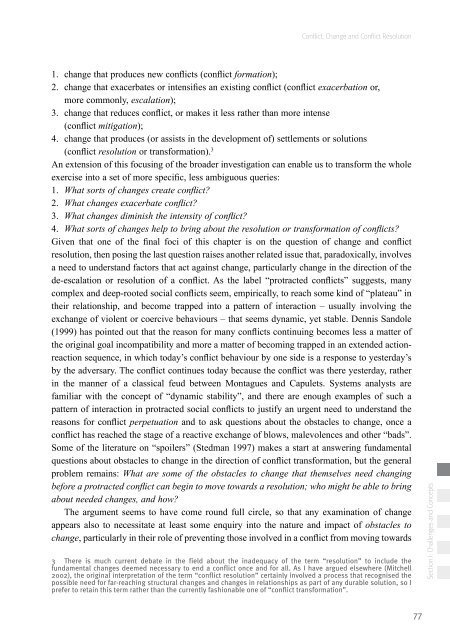Conflict, Change and Conflict Resolution - Berghof Handbook for ...
Conflict, Change and Conflict Resolution - Berghof Handbook for ...
Conflict, Change and Conflict Resolution - Berghof Handbook for ...
You also want an ePaper? Increase the reach of your titles
YUMPU automatically turns print PDFs into web optimized ePapers that Google loves.
<strong>Conflict</strong>, <strong>Change</strong> <strong>and</strong> <strong>Conflict</strong> <strong>Resolution</strong><br />
1. change that produces new conflicts (conflict <strong>for</strong>mation);<br />
2. change that exacerbates or intensifies an existing conflict (conflict exacerbation or,<br />
more commonly, escalation);<br />
3. change that reduces conflict, or makes it less rather than more intense<br />
(conflict mitigation);<br />
4. change that produces (or assists in the development of) settlements or solutions<br />
(conflict resolution or trans<strong>for</strong>mation). 3<br />
An extension of this focusing of the broader investigation can enable us to trans<strong>for</strong>m the whole<br />
exercise into a set of more specific, less ambiguous queries:<br />
1. What sorts of changes create conflict?<br />
2. What changes exacerbate conflict?<br />
3. What changes diminish the intensity of conflict?<br />
4. What sorts of changes help to bring about the resolution or trans<strong>for</strong>mation of conflicts?<br />
Given that one of the final foci of this chapter is on the question of change <strong>and</strong> conflict<br />
resolution, then posing the last question raises another related issue that, paradoxically, involves<br />
a need to underst<strong>and</strong> factors that act against change, particularly change in the direction of the<br />
de-escalation or resolution of a conflict. As the label “protracted conflicts” suggests, many<br />
complex <strong>and</strong> deep-rooted social conflicts seem, empirically, to reach some kind of “plateau” in<br />
their relationship, <strong>and</strong> become trapped into a pattern of interaction – usually involving the<br />
exchange of violent or coercive behaviours – that seems dynamic, yet stable. Dennis S<strong>and</strong>ole<br />
(1999) has pointed out that the reason <strong>for</strong> many conflicts continuing becomes less a matter of<br />
the original goal incompatibility <strong>and</strong> more a matter of becoming trapped in an extended actionreaction<br />
sequence, in which today’s conflict behaviour by one side is a response to yesterday’s<br />
by the adversary. The conflict continues today because the conflict was there yesterday, rather<br />
in the manner of a classical feud between Montagues <strong>and</strong> Capulets. Systems analysts are<br />
familiar with the concept of “dynamic stability”, <strong>and</strong> there are enough examples of such a<br />
pattern of interaction in protracted social conflicts to justify an urgent need to underst<strong>and</strong> the<br />
reasons <strong>for</strong> conflict perpetuation <strong>and</strong> to ask questions about the obstacles to change, once a<br />
conflict has reached the stage of a reactive exchange of blows, malevolences <strong>and</strong> other “bads”.<br />
Some of the literature on “spoilers” (Stedman 1997) makes a start at answering fundamental<br />
questions about obstacles to change in the direction of conflict trans<strong>for</strong>mation, but the general<br />
problem remains: What are some of the obstacles to change that themselves need changing<br />
be<strong>for</strong>e a protracted conflict can begin to move towards a resolution; who might be able to bring<br />
about needed changes, <strong>and</strong> how?<br />
The argument seems to have come round full circle, so that any examination of change<br />
appears also to necessitate at least some enquiry into the nature <strong>and</strong> impact of obstacles to<br />
change, particularly in their role of preventing those involved in a conflict from moving towards<br />
3 There is much current debate in the field about the inadequacy of the term “resolution” to include the<br />
fundamental changes deemed necessary to end a conflict once <strong>and</strong> <strong>for</strong> all. As I have argued elsewhere (Mitchell<br />
2002), the original interpretation of the term “conflict resolution” certainly involved a process that recognised the<br />
possible need <strong>for</strong> far-reaching structural changes <strong>and</strong> changes in relationships as part of any durable solution, so I<br />
prefer to retain this term rather than the currently fashionable one of “conflict trans<strong>for</strong>mation”.<br />
77<br />
Section I: Challenges <strong>and</strong> Concepts
















